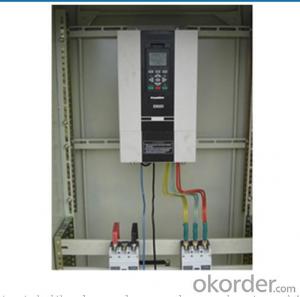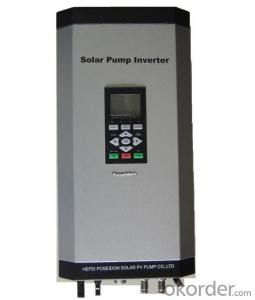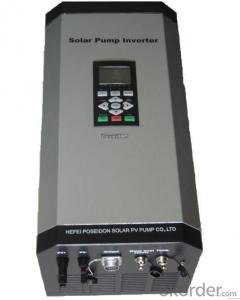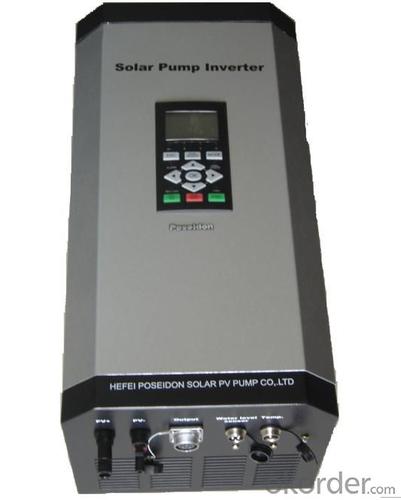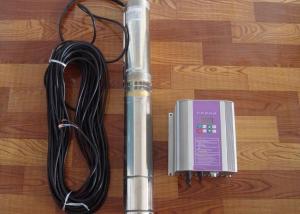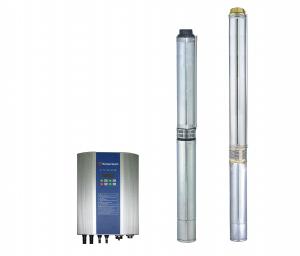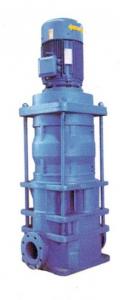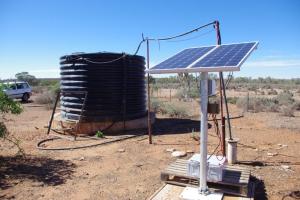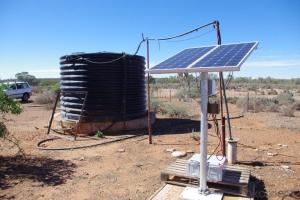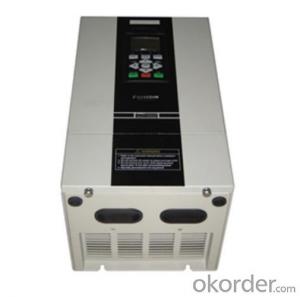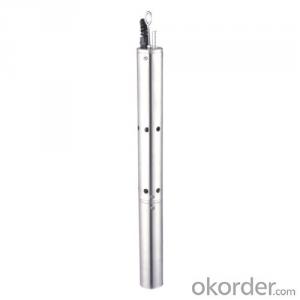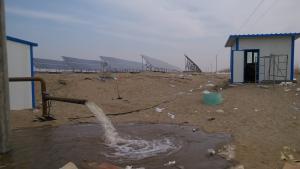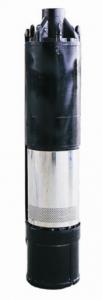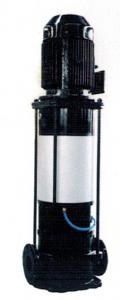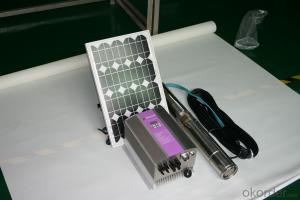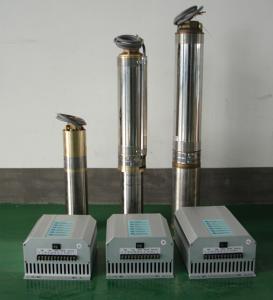1.5 Hp Solar Pump Inverter FCPM45KH
- Loading Port:
- China Main Port
- Payment Terms:
- TT OR LC
- Min Order Qty:
- -
- Supply Capability:
- -
OKorder Service Pledge
Quality Product, Order Online Tracking, Timely Delivery
OKorder Financial Service
Credit Rating, Credit Services, Credit Purchasing
You Might Also Like
Solar pump inverter FCPM45KH Product Description:
Solar water pumping system is constructed with solar panel array,solar pump inverter and AC water pump, DC current produced from solar panel will be delivered to solar pump inverter,and it will convert it into AC current to drive water pump,and will automatically regulate output frequency according to sun radiance intensity,maximally realize MPPT tracking function.
Features
Adopting the proposed dynamic VI maximum power point tracking (MPPT) control method, with fast response, and reliable operation, achieves efficiency of 99%.
Designed with variable frequency driver, greatly improves efficiency
Extremely high efficiency
Digital mode control, with automatic operation and manual operation mode options
Complete protection functions
Adopts intelligent IPM module, with high reliability
LCD display and operation panel, in real time presents operating data
Optional for water level measurement and control circuit
Applicable for general ACC pumps, like centrifugal pump, piston pump etc.
Independent intellectual property; Highly effective, the redundant reliability, exempts the maintenance and the long life.
The pumps are soft started, fully protected.
No batteries are used. So better Sunlight, more water.
Datasheet.
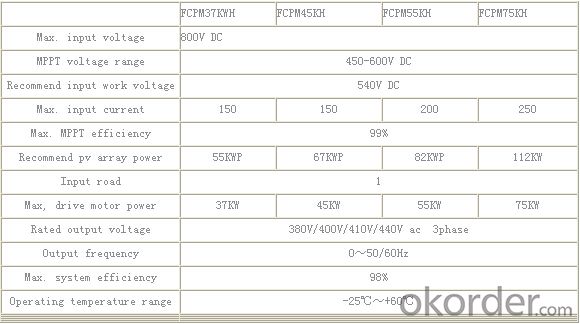
- Q: Can a solar pump be used for fountain or waterfall features?
- Yes, a solar pump can be used for fountain or waterfall features. Solar pumps are designed to run on solar energy, making them an eco-friendly and cost-effective option for powering water features. They can provide sufficient water flow and pressure to create beautiful fountains or cascading waterfalls, enhancing the aesthetics of any outdoor space without the need for electricity or batteries.
- Q: What is the maximum size of particles that a solar pump can handle?
- Depending on its specific model and design, the solar pump's capacity to handle particles of different sizes may vary. Generally, solar pumps are engineered to effectively manage particles that are small to medium in size. Such particles encompass dirt, sand, small pebbles, and various debris that may exist in the water source. The impeller or filtration system of the pump typically establishes the size limit. To ascertain the maximum particle size that a specific solar pump can accommodate, it is crucial to refer to the manufacturer's specifications or guidelines.
- Q: Can solar pumps be used for water supply in vineyards or orchards?
- Yes, solar pumps can be used for water supply in vineyards or orchards. Solar pumps are a sustainable and cost-effective solution for irrigation needs in agricultural settings. They use solar energy to power the pump, eliminating the need for electricity or fuel, making them ideal for remote or off-grid locations such as vineyards or orchards. Additionally, solar pumps offer flexibility in terms of installation and can efficiently meet the water demands of these agricultural areas, ensuring healthy growth and productivity of the crops.
- Q: Can a solar pump be used for water supply in residential communities or housing complexes?
- Certainly, water supply in residential communities or housing complexes can be facilitated by the use of a solar pump. Solar pumps present a viable alternative to traditional electric pumps, deriving their power from clean, renewable, and abundant solar energy. These pumps employ photovoltaic panels to convert sunlight into electricity, which then fuels the pump to extract water from sources like wells, boreholes, or reservoirs and distribute it to the desired destinations. The utilization of a solar pump for water supply in residential communities or housing complexes offers multiple advantages. Primarily, solar pumps prove to be cost-effective in the long term since they eliminate the need for fuel or electricity, thereby reducing energy expenses. Additionally, solar pumps require minimal maintenance, further contributing to cost savings. Moreover, solar pumps are environmentally friendly as they do not generate any greenhouse gas emissions or contribute to air pollution. They also aid in water conservation through the incorporation of sensors and controllers that optimize water usage and prevent wastage. Reliability and efficiency are hallmarks of solar pumps, enabling their operation even in remote areas with limited access to the electrical grid. These pumps ensure a consistent and uninterrupted water supply throughout the day, effectively meeting the needs of residential communities or housing complexes. In conclusion, solar pumps emerge as an exceptional choice for water supply in residential communities or housing complexes. They offer a plethora of benefits, including cost savings, environmental sustainability, and dependable operation. By harnessing the power of the sun, solar pumps provide a sustainable and efficient solution for satisfying the water demands of residential areas.
- Q: How does the installation cost of a solar pump compare to a traditional electric pump?
- Compared to a traditional electric pump, the installation cost of a solar pump is generally higher. This is because solar pumps require additional components like solar panels, inverters, and batteries, which can increase the overall installation expense. Furthermore, the complexity of installing a solar pump may necessitate specialized knowledge and expertise, adding further to the installation costs. In contrast, traditional electric pumps usually have a simpler installation process as they only require connection to the main electrical grid. The infrastructure for electric pumps is already established in most urban and rural areas, making the installation process more straightforward and cost-effective. Despite the higher installation cost, solar pumps offer numerous long-term benefits that can outweigh the initial expenditure. Solar pumps operate using renewable energy, significantly reducing or eliminating electricity bills, thus making them cost-effective in the long run. Additionally, solar pumps are eco-friendly and contribute to sustainable development by reducing carbon emissions and decreasing dependence on fossil fuels. Therefore, although the initial installation cost of a solar pump may be higher, the potential savings from reduced electricity bills and the environmental advantages make it a worthwhile investment in the long term.
- Q: Can a solar pump be used in areas with limited access to electricity?
- Yes, a solar pump can be used in areas with limited access to electricity. Solar pumps are designed to operate using solar energy, which converts sunlight into electricity to power the pump. This makes them an ideal solution for areas where conventional electricity is not readily available or unreliable. By harnessing the power of the sun, solar pumps can provide a sustainable and cost-effective solution for pumping water in remote locations, such as rural areas or off-grid communities. They can be used for various applications, including irrigation, livestock watering, or even providing clean drinking water. The availability of solar energy ensures that these pumps can continue functioning even in areas with limited access to electricity, making them an excellent option for promoting sustainable development and improving access to water resources in such regions.
- Q: Can a solar pump be used for flood control?
- Flood control can indeed utilize solar pumps. Equipped with photovoltaic panels, solar pumps convert sunlight into electricity to power their operations. These pumps are designed to function without the need for external power sources, making them an excellent choice for flood control in areas with limited or no access to electricity. Solar pumps have the capability to remove excess water from flood-affected regions, preventing further damage and aiding in the recovery process. They can efficiently move large amounts of water by either pumping it to higher ground or diverting it to designated drainage systems. The portability and ease of installation of solar pumps make them particularly valuable in emergency situations where quick response and flexibility are crucial. Moreover, solar pumps offer several advantages over traditional pumps for flood control. Firstly, they have lower operational costs since they rely on abundant and free solar energy. This makes them more sustainable and cost-effective in the long run. Additionally, solar pumps produce zero emissions, reducing their environmental impact and minimizing the carbon footprint associated with flood control efforts. To conclude, solar pumps are a viable and efficient option for flood control. Their ability to operate independently of the electrical grid, lower operational costs, and environmentally friendly nature make them a valuable tool for managing and mitigating floods in various settings.
- Q: Can a solar pump be used for cooling systems in data centers?
- Yes, a solar pump can be used for cooling systems in data centers. Solar pumps are commonly used in various applications, including heating and cooling systems. In the case of data centers, where cooling is of utmost importance to maintain optimal operating conditions, a solar pump can effectively circulate cool water or coolant to cool down the servers and equipment. Solar pumps work by using solar energy to power the pump, eliminating the need for electricity from the grid. They are typically connected to a solar panel or array, which converts sunlight into electricity. This electricity powers the pump, allowing it to circulate the cooling medium in the data center's cooling system. Using a solar pump for cooling systems in data centers has several benefits. Firstly, it reduces the reliance on traditional electricity sources, leading to cost savings and a more sustainable operation. Solar energy is renewable and abundant, making it an environmentally friendly choice for powering data center cooling systems. Additionally, solar pumps are often designed to be highly efficient, ensuring the maximum utilization of solar energy. This efficiency translates into better performance and reduced energy consumption, which is crucial for data centers aiming to optimize their energy usage and reduce carbon footprint. However, it is important to note that the use of solar pumps for cooling systems in data centers may not be suitable in all situations. The effectiveness of solar-powered cooling depends on factors such as the availability of sunlight, the size of the data center, and the cooling requirements. In some cases, a combination of solar and traditional electricity sources might be necessary to meet the cooling demands of a data center. Overall, a solar pump can certainly be used for cooling systems in data centers, providing a sustainable and energy-efficient solution to meet the cooling needs of these critical facilities.
- Q: How does the altitude or elevation affect the performance of a solar pump?
- The altitude or elevation affects the performance of a solar pump primarily due to the changes in atmospheric pressure. As one goes higher in altitude, the atmospheric pressure decreases, which in turn affects the pump's ability to generate suction and lift water. At higher altitudes, the pump may experience reduced efficiency and lower water output. Additionally, lower atmospheric pressure can also impact the efficiency of the solar panels used to power the pump, leading to decreased power generation. Therefore, it is important to consider and adjust for the altitude or elevation when designing and installing a solar pump system.
- Q: Does the angle and orientation of the solar panels affect the performance of a solar pump system?
- Yes, the angle and orientation of solar panels can significantly affect the performance of a solar pump system. The angle determines the tilt of the panels, which affects the amount of sunlight they receive. By adjusting the angle based on the geographical location and season, the panels can maximize their exposure to the sun's rays, leading to optimal energy generation and pump performance. Similarly, the orientation of the panels, such as facing them towards the south in the Northern Hemisphere, ensures they capture sunlight at the most direct angle throughout the day. Consequently, correct angle and orientation are crucial for maximizing the efficiency and effectiveness of a solar pump system.
Send your message to us
1.5 Hp Solar Pump Inverter FCPM45KH
- Loading Port:
- China Main Port
- Payment Terms:
- TT OR LC
- Min Order Qty:
- -
- Supply Capability:
- -
OKorder Service Pledge
Quality Product, Order Online Tracking, Timely Delivery
OKorder Financial Service
Credit Rating, Credit Services, Credit Purchasing
Similar products
Hot products
Hot Searches
Related keywords
